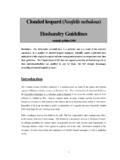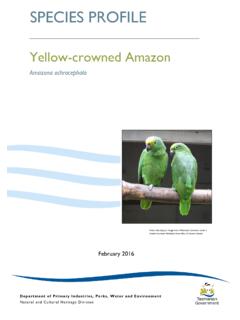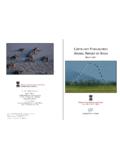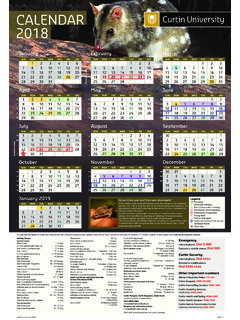Transcription of Trophy Hunting by the Numbers - Humane Society …
1 1 Trophy Hunting by the Numbers THE UNITED STATES ROLE IN GLOBAL Trophy Hunting 1 EXECUTIVE SUMMARY We undertook a study to determine the impact of American Trophy hunters on wildlife in other countries. To conduct this research, we examined wildlife Trophy import trade data obtained from the Fish and Wildlife Service (USFWS) Law Enforcement Management Information System (LEMIS). Between 2005 and 2014, more than million wildlife trophies were imported to the , with an average of more than 126,000 trophies every year. Most originated in Canada and South Africa, but other top countries of origin included Namibia, Mexico, Zimbabwe, New Zealand, Tanzania, Argentina, Zambia and Botswana. Trophies of more than 1,200 different kinds of animals were imported during the decade studied, including nearly 32,500 trophies of the Africa Big Five species: approximately 5,600 African lions, 4,600 African elephants, 4,500 African leopards, 330 southern white rhinos and 17,200 African buffalo.
2 The top ten species imported during the decade were snow geese, mallards, Canada geese, American black bears, impalas, common wildebeests, greater kudus, gemsboks, springboks and The top five ports of entry for wildlife trophies during the decade were: New York, NY; Pembina, ND; Chicago, IL; Dallas/Fort Worth, TX; and Portal, These ports provide an entry point for the trophies, which should interest local lawmakers concerned about Trophy Hunting . The African lion is listed as Vulnerable on the International Union for the Conservation of Nature Red List of threatened Species ( iucn red list ) and Endangered and threatened under the Endangered Species Act (ESA).4 African lion Trophy hunts can cost USD$13,500-49,000. African lion trophies were imported primarily from South Africa, Tanzania, Zimbabwe, Zambia and Namibia.
3 African lion trophies Publication Date: February 2016 2 entered the through the following top five ports: New York City, Houston, San Francisco, Chicago and Dallas. The African elephant is listed as Vulnerable on the iucn red list and threatened under the African elephant hunts can cost USD$11,000-70,000. African elephant trophies were imported primarily from Zimbabwe, Botswana, South Africa, Tanzania, Namibia and Zambia. Elephant trophies entered the through the following top five ports: New York City, Dallas, Houston, San Francisco and Chicago. The African leopard is listed as Near threatened on the iucn red list and Endangered and threatened under the African leopard hunts can cost USD$13,000-24,000. Leopard trophies were imported primarily from Zimbabwe, Tanzania, Namibia, South Africa,7 Zambia, Botswana and Mozambique.
4 Leopard trophies entered the through the following top five ports: New York City, Houston, San Francisco, Dallas and Chicago. The southern white rhino is listed as Near threatened on the iucn red list and threatened under the Southern white rhino hunts can cost USD$55,000-150,000. Southern white rhino trophies were imported primarily from South Africa and Namibia. Southern white rhino trophies entered the through the following top five ports: New York City, San Francisco, Houston, Dallas and Chicago. The African buffalo is listed as Least Concern on the IUCN Red African buffalo hunts can cost USD$15,000-18,500. African buffalo trophies were primarily imported from Zimbabwe, Tanzania, South Africa, Zambia, Mozambique, Botswana, Cameroon, Namibia, Central African Republic and Burkina Faso.
5 African buffalo trophies entered the through the following top five ports: New York City, Houston, Dallas, San Francisco and Chicago. INTRODUCTION Trophy Hunting is defined as killing wild animals for their body parts, such as head and hide, for display but not primarily for food or sustenance. Trophies include, but are not limited to, parts such as elephant ivory tusks, rhino horns or deer antlers to entire heads that can be mounted on walls or complete bodies that can be formed into life-like poses by a taxidermist. Trophy hunters display their trophies in their homes or offices. A recent study that examined the motivation for Trophy Hunting found that hunters glamorize the killing of an animal so as to demonstrate virility, prowess and Trophy hunters are also motivated by the competitions sponsored by Trophy Hunting organizations.
6 The world s largest Trophy Hunting advocacy organization is Safari Club International (SCI) which reportedly has 50,000 SCI gives Hunting awards in dozens of categories, including the Africa Big Five, for which a hunter must kill an African lion, an African elephant, an African leopard, an African rhino and an African buffalo. Other competitions include Bears of the World, in which a hunter must kill four of eleven types of bears; Cats of the World, in which a hunter has to kill four of seven types of cats; and Spiral-horned Animals of Africa, in which a hunter has to kill 17 different types of animals. Inner Circle awards recognize various Hunting achievements, such as killing animals with a handgun, killing animals on each continent and getting the most entries into the SCI record book.
7 To win the highest SCI award, known as World Hunter of the Year, a hunter must kill more than 300 animals across the globe. Another type of competition is to kill the highest scoring animals. SCI, like other Trophy Hunting clubs, maintains record books. They record kills that meet certain standards, such as horn or antler size. These standards are used to establish a score for each Trophy ; high scores are very desired by Trophy hunters who compete with one another. Trophy hunters often kill more than one animal of a certain species as they are constantly trying to achieve a higher score. For example, one Trophy hunter has killed six elephants, two rhinos, 18 African lions and 13 The competitions and record book scores, as well as annual conventions where hunters and Hunting providers meet to arrange trips for the upcoming year, encourage Trophy hunters to kill more and more animals.
8 3 While Africa is certainly a major destination for Trophy hunters, Trophy Hunting also occurs in the , Canada, Mexico, Argentina, New Zealand and Spain, to name a few countries. According to 2009 estimates, approximately 18,50013 Trophy hunters visit Africa every year to kill approximately 105,000 Of these, the overwhelming majority nearly 15,000 are from the Many of the species sought by Trophy hunters are threatened with extinction. For example, among the four animals a hunter must kill to win the SCI Africa Big Five award, four are threatened with extinction: the African lion, African elephant, African leopard and African rhino (the southern white rhino or the black rhino).16 Biologists have significant concerns about the harm to wildlife because of Trophy Hunting .
9 The sustainability of off-take rates is questioned17 because Hunting quotas are frequently set without a solid scientific understanding of the size of wildlife populations and ability to recover from persecution. Furthermore, age restrictions for hunted animals are commonly Many Trophy hunters partake in hunts of introduced non-native species that, although harmful to native wildlife and the environment, are maintained in the wild in some countries for the purpose of Trophy Hunting . This includes, for example, blackbuck, water buffalo and red deer that can be hunted in Argentina; and red deer, chamois, fallow deer, Himalayan tahr, sambar deer and sika deer that can be hunted in New Zealand. Other Trophy hunters kill animals that are purposefully bred for the bullet and hunted in fenced areas where the animal has no chance of escaping.
10 Canned Hunting is recognized by both conservationists and hunters19 to have no benefit for wild populations. in fact, these facilities are a serious cause for alarm because of disease transmission to wild Examples of such hunts are the ubiquitous Trophy white-tailed deer production facilities in the and Canada; facilities in Texas that breed and offer to Trophy hunters exotic species such as addax and Arabian oryx; and South Africa s canned African lion Hunting industry. The purpose of this study was to determine the effect of American Trophy hunters on wildlife worldwide by examining the number and types of wild animals imported as trophies to the over a ten-year period. METHODOLOGY This report contains an original analysis of Hunting Trophy import data obtained under Freedom of Information Act requests to the USFWS.








